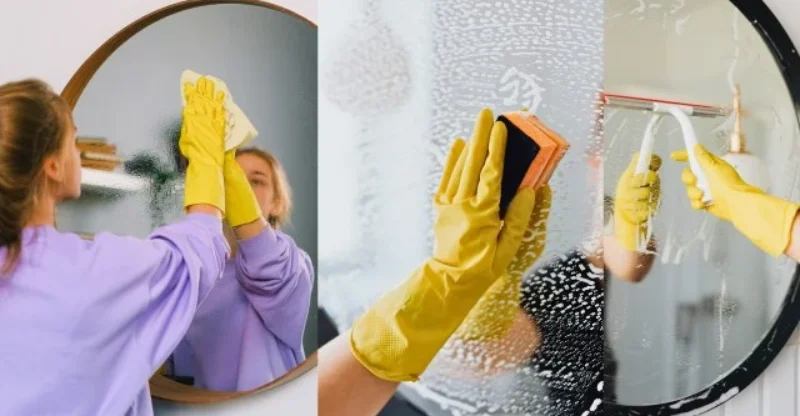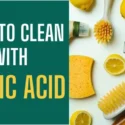How to Clean a Mirror That is Hazy?
Mirrors are an essential part of our daily lives. From getting ready in the morning to checking our appearance throughout the day, we rely on mirrors to reflect reality.
However, a hazy mirror can distort this reality, making it difficult to see clearly. Over time, mirrors can accumulate a layer of residue from dust, fingerprints, and other particles in the air.
This residue can create a cloudy appearance, often referred to as haze. Additionally, improper cleaning techniques, such as using abrasive cleaners or wiping with a rough cloth, can scratch the mirror’s surface and contribute to its hazy appearance.
Finally, mirrors can also become hazy due to de-silvering, which occurs when the reflective silver coating on the back of the mirror begins to deteriorate.
In this guide, we’ll explore how to effectively clean a mirror that has become hazy, ensuring a clear and accurate reflection.
Materials for Cleaning a Hazy Mirror
- Commercial Glass cleaner
- Microfiber cloth
- Cotton pads
- Jeweler’s rouge
Guide to Cleaning a Hazy Mirror
Cleaning a hazy mirror doesn’t have to be a daunting task. Following these steps, you can restore your mirror to its original clarity.
Step #1: Preparing Your Mirror for Cleaning
Before you start cleaning, remove any dust or loose particles from the mirror’s surface. Gently wipe the mirror with a dry microfiber cloth. This step is crucial because it prevents you from scratching the mirror when you apply the cleaning solution.
Step #2: Choosing the Right Cleaning Solution
There are many cleaning solutions you can use to clean a hazy mirror. Commercial glass cleaners are popular because they are designed to clean glass surfaces without leaving streaks.
However, if you prefer a more natural solution, you can make your own at home using vinegar and water. Mix equal parts of vinegar and water in a spray bottle, and you have an effective and eco-friendly homemade cleaning solution.
Step #3: Applying the Cleaning Solution
Spray your chosen cleaning solution onto a microfiber cloth or a cotton pad, then gently wipe the mirror.
Avoid spraying the solution directly onto the mirror, as this can cause the solution to seep into the edges and damage the backing.
Make sure to wipe in one direction (either horizontally or vertically) to prevent streaks.
Step #4: Wiping and Polishing the Mirror
After you’ve applied the cleaning solution, it’s time to wipe and polish the mirror. Wipe the mirror in the same direction as before using a clean, dry microfiber cloth.
This will remove any remaining cleaning solution and polish the mirror, leaving it sparkling clean.
Detailed Cleaning Methods
There are several methods you can use to clean a hazy mirror. Here are some of the most effective ones:
Method #1: Using Rubbing Alcohol
Rubbing alcohol is a powerful cleaning agent that can cut through tough grime and haze. To use this method, apply some rubbing alcohol to a cotton pad and gently wipe the mirror.
Afterward, use a dry microfiber cloth to polish the mirror and remove any streaks.
Method #2: Using Vinegar
Vinegar is a natural cleaning solution that effectively removes haze from mirrors. Mix equal parts of vinegar and water in a spray bottle.
Spray the solution onto a microfiber cloth and wipe the mirror. Rinse with water and dry with a clean cloth.
Method #3: Using Shaving Cream
Shaving cream is another surprising yet effective way to clean a hazy mirror. Apply a small shaving cream to a microfiber cloth and rub it onto the mirror.
Then, wipe off the shaving cream with a clean cloth. This method cleans the mirror and leaves a protective layer that prevents fogging.
Method #4: Using Jeweler’s Rouge
Jeweler’s rouge is a type of polishing compound that can remove stubborn haze from mirrors. Apply a small amount of jeweler’s rouge to a cloth and gently rub it onto the mirror.
Then, wipe off the compound with a clean cloth.
Method #5: Using Commercial Glass Cleaners
Commercial glass cleaners are designed to clean glass surfaces, making them a good choice for cleaning mirrors. Spray the cleaner onto a cloth and wipe the mirror.
For the best results, be sure to follow the manufacturer’s instructions.
Additional Cleaning Methods
In addition to the methods mentioned above, several cleaning methods suggested by various communities have proven effective.
Here are some of them:
Distilled Water: Some people have used distilled water to clean their mirrors. The lack of minerals in distilled water can help prevent streaks and residue.
Acetone: Acetone, a common ingredient in nail polish remover, effectively cuts through tough grime. However, it should be used cautiously, as it can damage some surfaces.
Dish Soap and Distilled Water: A simple solution of dish soap and distilled water can effectively remove haze from mirrors. The soap helps to break down the grime, while the purified water rinses it away without leaving residue.
Isopropyl Alcohol: Similar to rubbing alcohol, isopropyl alcohol can effectively cut through tough grime and haze. It evaporates quickly, reducing the chance of streaks.
Optical Cleaning Solutions: Some people recommend using optical cleaning solutions designed for cleaning glasses and camera lenses to clean mirrors. These solutions are gentle yet effective, making them a good choice for delicate mirrors.
When to Consider Professional Mirror Cleaning
Despite your best efforts, there may come a time when you need to consider professional cleaning or even mirror replacement.
Here are some signs that it might be time to call in the professionals:
Persistent Haze: Consider professional cleaning if your mirror is still hazy after multiple cleaning attempts. A professional cleaner has access to specialized tools and cleaning solutions that can often remove haze that household products can’t.
Scratches or Damage: If your mirror has scratches or other physical damage, a professional cleaner can repair it. However, if the damage is severe, replacing the mirror might be more cost-effective.
Desilvering: Desilvering is a process where the reflective coating on the back of the mirror begins to deteriorate. This can cause dark spots or patches on the mirror. Unfortunately, the desilvering can’t be repaired by cleaning, and the mirror must be replaced.
FAQs
While some people swear by this method, others find it leaves ink residue on the mirror. A microfiber cloth is generally a safer choice.
This can be due to residue left behind by the cleaning solution. Make sure to thoroughly rinse and dry your mirror after cleaning.
Toothpaste can be used to clean mirrors, but it should be used sparingly and rinsed thoroughly, as it can leave a residue.
Regular cleaning and using a dehumidifier or exhaust fan to control humidity can help prevent your mirror from fogging up.



